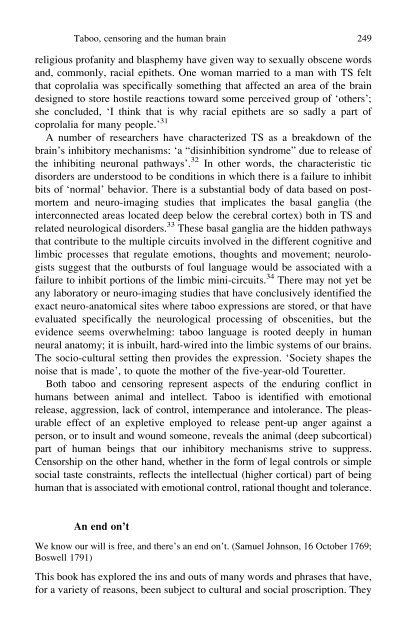Forbidden Words: Taboo and the Censoring of Language
Forbidden Words: Taboo and the Censoring of Language
Forbidden Words: Taboo and the Censoring of Language
Create successful ePaper yourself
Turn your PDF publications into a flip-book with our unique Google optimized e-Paper software.
<strong>Taboo</strong>, censoring <strong>and</strong> <strong>the</strong> human brain 249<br />
religious pr<strong>of</strong>anity <strong>and</strong> blasphemy have given way to sexually obscene words<br />
<strong>and</strong>, commonly, racial epi<strong>the</strong>ts. One woman married to a man with TS felt<br />
that coprolalia was specifically something that affected an area <strong>of</strong> <strong>the</strong> brain<br />
designed to store hostile reactions toward some perceived group <strong>of</strong> ‘o<strong>the</strong>rs’;<br />
she concluded, ‘I think that is why racial epi<strong>the</strong>ts are so sadly a part <strong>of</strong><br />
coprolalia for many people.’ 31<br />
A number <strong>of</strong> researchers have characterized TS as a breakdown <strong>of</strong> <strong>the</strong><br />
brain’s inhibitory mechanisms: ‘a “disinhibition syndrome” due to release <strong>of</strong><br />
<strong>the</strong> inhibiting neuronal pathways’. 32 In o<strong>the</strong>r words, <strong>the</strong> characteristic tic<br />
disorders are understood to be conditions in which <strong>the</strong>re is a failure to inhibit<br />
bits <strong>of</strong> ‘normal’ behavior. There is a substantial body <strong>of</strong> data based on postmortem<br />
<strong>and</strong> neuro-imaging studies that implicates <strong>the</strong> basal ganglia (<strong>the</strong><br />
interconnected areas located deep below <strong>the</strong> cerebral cortex) both in TS <strong>and</strong><br />
related neurological disorders. 33 These basal ganglia are <strong>the</strong> hidden pathways<br />
that contribute to <strong>the</strong> multiple circuits involved in <strong>the</strong> different cognitive <strong>and</strong><br />
limbic processes that regulate emotions, thoughts <strong>and</strong> movement; neurologists<br />
suggest that <strong>the</strong> outbursts <strong>of</strong> foul language would be associated with a<br />
failure to inhibit portions <strong>of</strong> <strong>the</strong> limbic mini-circuits. 34 There may not yet be<br />
any laboratory or neuro-imaging studies that have conclusively identified <strong>the</strong><br />
exact neuro-anatomical sites where taboo expressions are stored, or that have<br />
evaluated specifically <strong>the</strong> neurological processing <strong>of</strong> obscenities, but <strong>the</strong><br />
evidence seems overwhelming: taboo language is rooted deeply in human<br />
neural anatomy; it is inbuilt, hard-wired into <strong>the</strong> limbic systems <strong>of</strong> our brains.<br />
The socio-cultural setting <strong>the</strong>n provides <strong>the</strong> expression. ‘Society shapes <strong>the</strong><br />
noise that is made’, to quote <strong>the</strong> mo<strong>the</strong>r <strong>of</strong> <strong>the</strong> five-year-old Touretter.<br />
Both taboo <strong>and</strong> censoring represent aspects <strong>of</strong> <strong>the</strong> enduring conflict in<br />
humans between animal <strong>and</strong> intellect. <strong>Taboo</strong> is identified with emotional<br />
release, aggression, lack <strong>of</strong> control, intemperance <strong>and</strong> intolerance. The pleasurable<br />
effect <strong>of</strong> an expletive employed to release pent-up anger against a<br />
person, or to insult <strong>and</strong> wound someone, reveals <strong>the</strong> animal (deep subcortical)<br />
part <strong>of</strong> human beings that our inhibitory mechanisms strive to suppress.<br />
Censorship on <strong>the</strong> o<strong>the</strong>r h<strong>and</strong>, whe<strong>the</strong>r in <strong>the</strong> form <strong>of</strong> legal controls or simple<br />
social taste constraints, reflects <strong>the</strong> intellectual (higher cortical) part <strong>of</strong> being<br />
human that is associated with emotional control, rational thought <strong>and</strong> tolerance.<br />
An end on’t<br />
We know our will is free, <strong>and</strong> <strong>the</strong>re’s an end on’t. (Samuel Johnson, 16 October 1769;<br />
Boswell 1791)<br />
This book has explored <strong>the</strong> ins <strong>and</strong> outs <strong>of</strong> many words <strong>and</strong> phrases that have,<br />
for a variety <strong>of</strong> reasons, been subject to cultural <strong>and</strong> social proscription. They

















